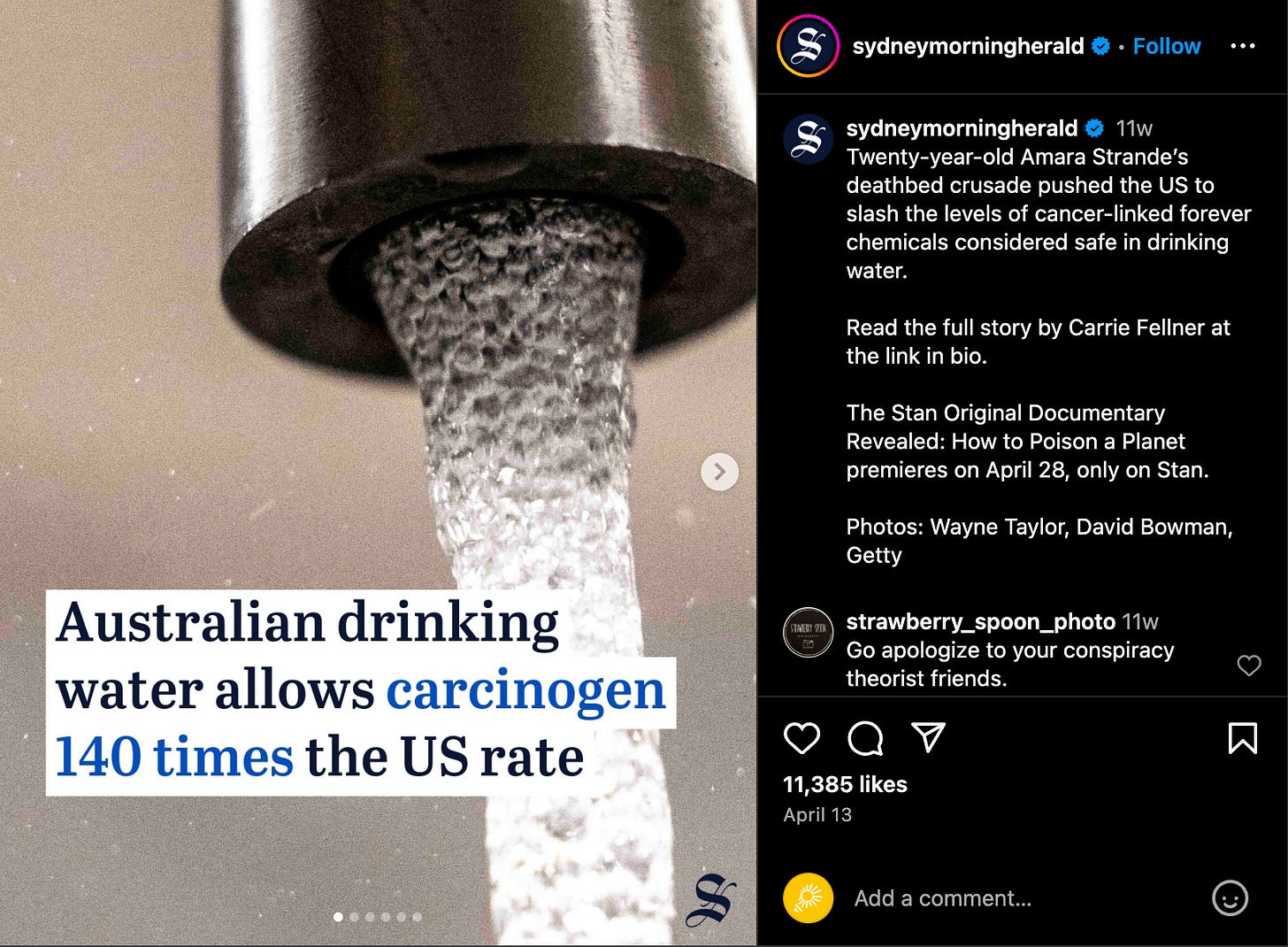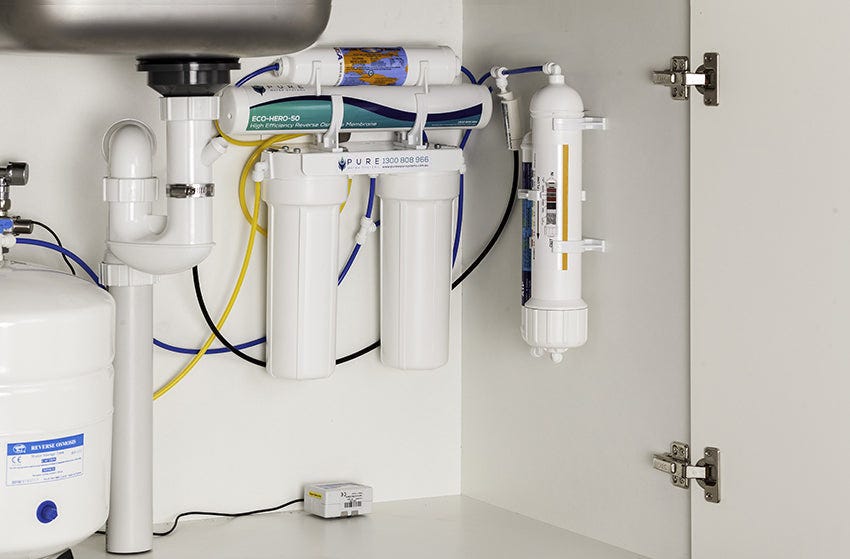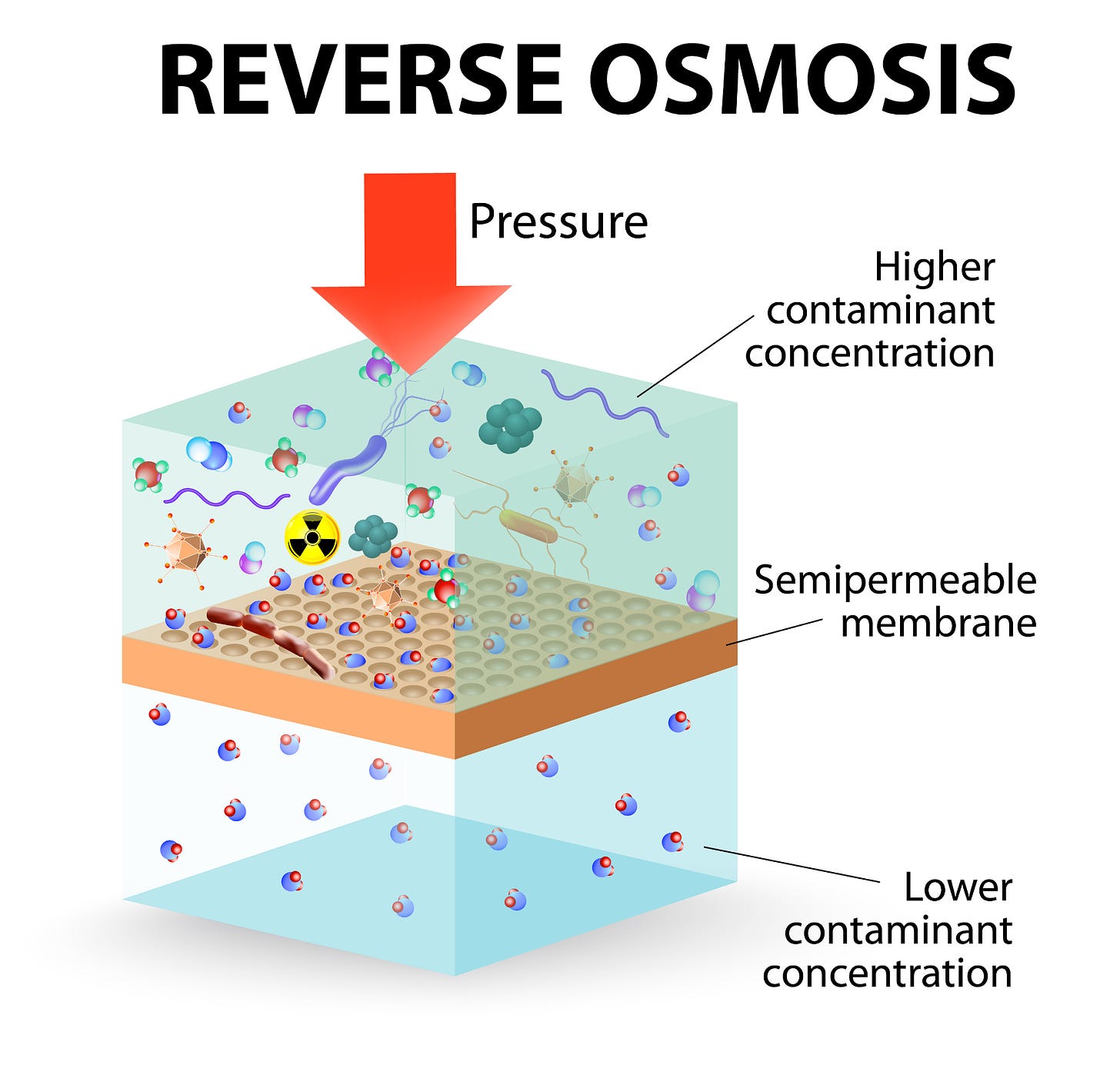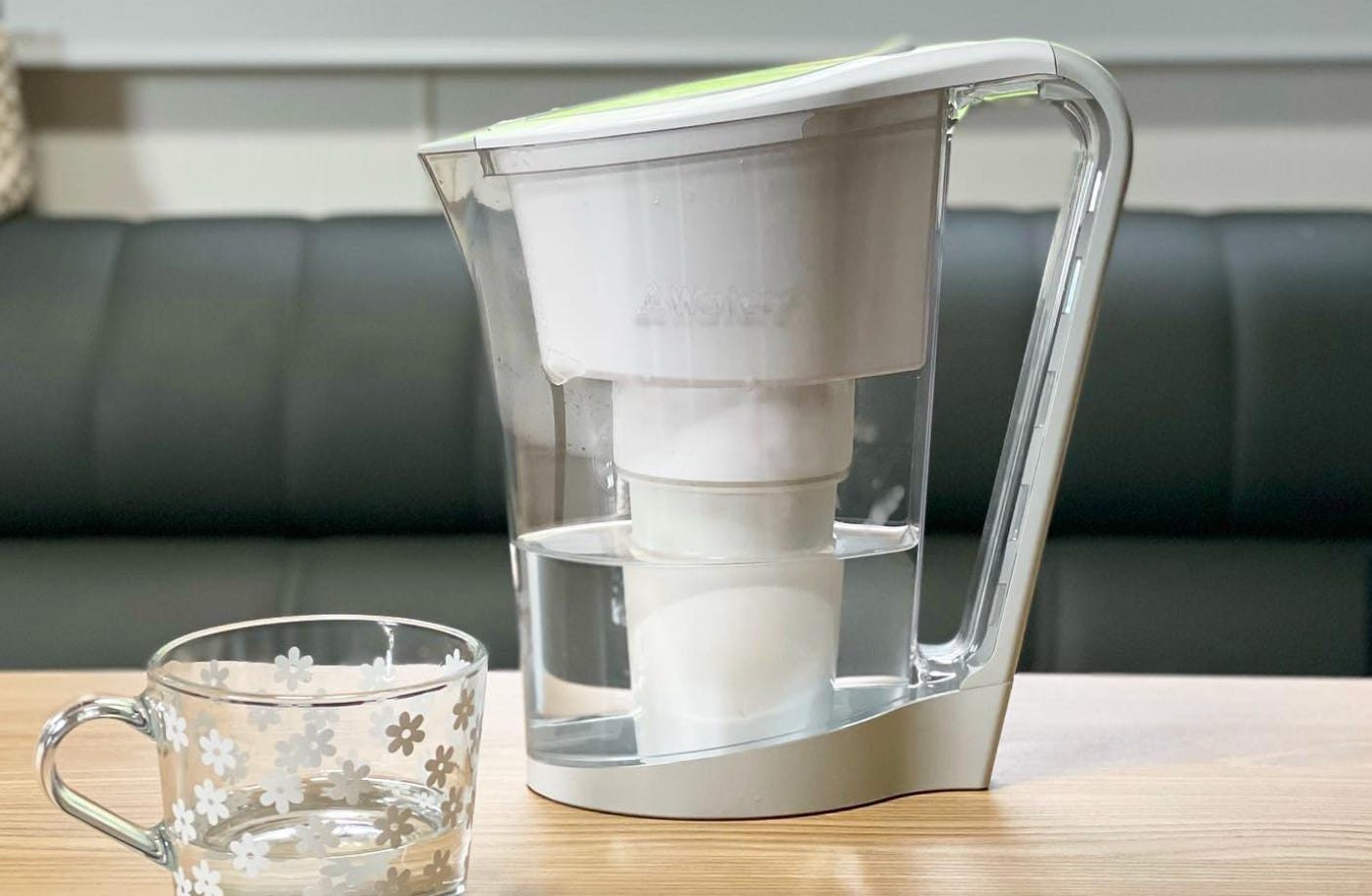THE MAINSTREAM MEDIA IS CATCHING ON (FINALLY)
If this news has finally reached the mainstream, we know it’s worse than they are letting on.
As quoted from The Age and The Sydney Morning Herald in a 9News article, “The contaminants - perfluorooctane sulfonate (PFOS) and perfluorooctanoic acid (PFOA) - have been found in tap water in every state and territory” Contrary to what our Aussie government and water authorities are touting, The Sydney MorningHerald reports that there is in fact no such thing as a “safe level” of carcinogens or chemicals in our tap water, and the 9News article repeats this statement from US authorities that there is quote, “no safe level of exposure”.
On the Today show, Dr Mariann Lloyd-Smith from the International Pollutant Elimination Network told interviewers that the chemicals concerned have been linked to kidney and liver disease, as well as thyroid, insulin, hormone, immune and reproductive problems, and developmental problems in children…not to mention cancer. She went on to say quote, “Unbelievably though our regulatory agencies here in Australia just dismiss all of this evidence, and say there’s no clear evidence that they cause disease, which honestly is beyond belief.
Our ever-faithful Australian government and water authorities promise that our water is fine, and remind us that it undergoes standard treatment for safety. That standard treatment, by the way, often includes adding “safe levels of chemical disinfectants” (A.K.A, adding known carcinogens and other chemicals and contaminants to your water, for free!) - and they still don’t even claim to remove all impurities from your water.
Even the World Health Organisation's cancer agency has found and admitted that PFOA is carcinogenic to humans, and PFOS is “possibly” carcinogenic to humans. Not to mention that the Australian government’s maximum legal limits of the ‘forever chemicals’ PFOA and PFOS in drinking water is 560 parts per trillion for PFOA and 70 parts per trillion for PFOS, compared to the USA’s 4 parts per trillion for both. Thats 140 times higher than the US benchmark.
Everyone from SkyNews to The Sydney Morning Herald, ABC, 9News, The Age, and The Australian is actually imploring you to start filtering your tap water.
Could there be a better time to talk about the importance of water filtration? Unlike the news, though, we’re not just talking about your tap/drinking water - we’re also talking about the water you shower in. Yup, it’s all important.
WATER FILTRATION - THE WHAT AND THE WHY
Oxidative stress and cell damage → chronic inflammation → collagen fragmentation, disorganisation of collagen fibres and skin cell functions → loss of cellular energy → skin that is dull, dry (dehydrated), irritated, and ageing, as well as skin disease.
Another important thing to note is that, whenever possible, you should avoid drinking water straight from the tap or even from plastic bottles (microplastics). In terms of quality, the water in plastic water bottles in particular has much lighter governmental restrictions and regulations than those placed on the standard treatment of tap water - and we’ve discussed how ineffective that has proven to be.
When your water is contaminated with chemicals and other impurities, you will be contaminated with chemicals and other impurities, and the consequences on your health just aren’t worth it.
So beyond those nasty carcinogenic PFAS, PFOS and PFOA, what else may be lurking in your water and causing you dis-ease?
Common contaminants include:
- Chlorine and chloramine: These guys are often used as sanitisers and disinfectants. Chlorine is known to produce carcinogenic (cancer-causing) by-products like trihalomethanes or THMs (which have been linked to increased risk for bladder cancer), and chlorine has also been linked to respiratory issues. Chloramine is literally just chlorine with ammonia added to it - and what is ammonia? It is an inorganic chemical compound often used in cleaning products and fertilisers, and is also used in the manufacture of plastics, explosives, dyes, and pharmaceuticals. Ammonia exposure is known to deeply irritate the skin, eyes and lungs. In order to prevent the release of its toxic fumes, it is said that ammonia should not be mixed with other chemicals (especially chlorine bleach). The ammonia in chloramine, by the way, is added to the chlorine component for the sole purpose of making it last longer! These contaminants are not only terrible for your health, they are detrimental to local marine life. Also, they are basically impossible to remove from your water without the use of a specialist filtration system.
- Fluoride: Fluoride has been shown to cause serious health issues including neurological, reproductive, cardiovascular, and thyroid problems, high blood pressure, and skeletal weakness (and even a bone disease known as skeletal fluorosis). It also unwinds the triple helix of collagen, which increases the risk of tissue injuries and strain, slows the rate of bone regeneration (contributing to conditions like bone cancer, TMJ, and osteoarthritis), and also contributes to skin issues. This also means that excess fluoride intake will basically negate any positive effects you may gain from taking a collagen supplement, for example. Contradictory as it sounds, some (most? All?) municipal systems and local water authorities admit to adding fluoride into the waterways. Why? They say it is “good for your teeth” - even though excessive intake can actually weaken tooth enamel and cause discolouration (dental fluorosis). Given that many people are already exposed to fluoride in toothpaste and pharmaceuticals, on top of the water they drink and shower in, you can bet that they are consuming excessive amounts.
- PFAS (per- and polyfluoroalkyl substances, including PFOS and PFOA): PFAS contaminate 95% of the world’s water supplies and can be found in almost every common household product including non-stick cookware, cosmetics, clothing, and food packaging (and therefore, the food itself). These little atrocities are nicknamed ‘forever chemicals’ because once they are in our environment or our bodies, they cannot break down and accumulate, and linger in the body for years. On top of destroying the environment and natural ecosystems, PFAS can cause serious health issues like infertility, hormone interference, thyroid disease, suppressed immune function, developmental issues in children, and even cancer.
- Hard water and limescale: Hard water is water with a very high mineral content, especially calcium and magnesium, which some areas are more prone to than others. This can make your home more susceptible to limescale (caused by calcium molecules), which builds up in pipes, faucets, and appliances (e.g., dishwashers, washing machines, kettles, and coffee machines) and causes performance issues and breakdowns. Hard water itself can also cause dry skin and hair.
- Heavy metals: These include cadmium, manganese, lead, arsenic, chromium, and mercury - the first four of which appear on the World Health Organisation’s (WHO) list of chemicals of public concern. While small amounts of some of these are necessary for your health (e.g., zinc, iron, and copper), excessive intake can be highly toxic. Even the legal limits can pose a significant health risk for immunocompromised individuals. Heavy metals can wreak havoc on the musculoskeletal, circulatory, metabolic, immune, and digestive/gastrointestinal systems, as well as the lungs, brain, kidneys, and liver; they can lead to organ damage and disrupt growth and cell repair, not to mention their carcinogenic (cancer-causing) effect.
- Sand, silt, rust, and sediment: These can cause gastrointestinal discomfort, flu-like symptoms, and particularly bad tasting/smelling water. Silt, in particular, can contain PCBs (polychlorinated biphenyls which are highly carcinogenic chemical compounds), chlorides, sulphates, and dangerous bacteria, viruses, and microorganisms (e.g., E.coli and Salmonella).
- Pesticides and herbicides: Pesticides are chemicals that are used to kill pests and can remain in water for years, while herbicides are chemicals used to kill weeds. These have been linked to various health issues from early-onset Parkinson’s disease to cancer (carcinogenic), and can have highly detrimental effects on the nervous and hormone/endocrine systems. You may have heard of the infamous herbicide atrazine; research done with low doses of atrazine was shown to alter the genetic characteristics of frogs, causing male frogs to develop female reproductive organs.
- Pharmaceuticals: Medicines ranging from antibiotics and ibuprofen to hormones and narcotic pain relievers have been found in tap water. These can cause flare-ups in allergies, and even cause nerve damage. Pregnant women, the elderly, and immunocompromised individuals are even more at risk. The biggest concerns are about about chronic low-level exposure to certain drug classes, such as: chemotherapeutic drugs which can act as powerful poisons, hormones that can negatively affect reproductive health and overall development, medicines for depression and epilepsy that can damage the brain and are behaviour-altering, and antibiotics that can allow human germs to mutate into more dangerous forms.
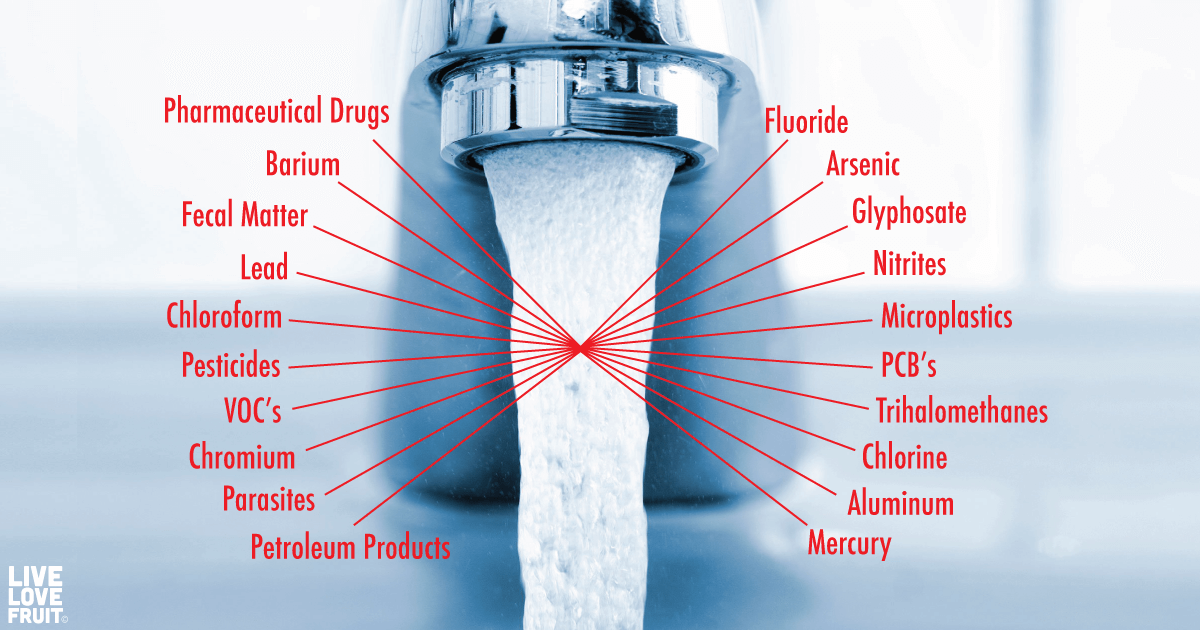
WATER FILTRATION - THE HOW
REVERSE OSMOSIS (RO)
What
These systems were originally designed to desalinate seawater and reduce high chemical contaminants. RO systems are considered one of the best and safest all-around effective methods of water filtration, as they can significantly remove PFAS, up to 99% of lead, asbestos and 82 other additional contaminants, as well as over 90% of fluoride. They do not, however, remove all dissolved gases, chemicals, or volatile organic compounds (VOCs - e.g., from pesticides).
How
They work by pushing your water through a tiny (microscopic), semi-permeable filter material that essentially allows only the small water molecules to get through while preventing any larger molecules (i.e., contaminants, but also salt and other minerals) from doing so. It essentially breaks down your water into its most basic molecules.
The word ‘osmosis’ refers to the process by which molecules from a more weakly concentrated solution pass through a membrane into a more strongly concentrated solution, until both solutions are of the same concentration. Reverse osmosis systems simply add much more pressure in order to move the water molecules out of the contaminated water (more strongly concentrated solution) and into a purified, filtered water (more weakly concentrated solution).
Whole-House/Under the Sink vs Countertop
These are typically installed under the sink or retrofitted as a whole-house system (so that includes your shower water), and are hence quite pricey and hard to maintain - some systems, in fact, will require both professional installation and maintenance.
Cost and Maintenance
The filters in RO systems have to be replaced quite often as ‘excess mineral gunk’ builds up quickly, which has led some people to question the overall purity of RO systems. That being said, the jury is still out on this one, with many in the mitochondriac and wellness communities still opting for an RO system - so let’s not label it as “bad” water filtration option just yet. Just note that they can be quite pricey, hard to maintain, and tend to waste more water than they produce/provide (in terms of volume, anywhere between 3 and 20 times as much; which leads to higher water bill costs).
DISTILLER
What
Like RO systems, distiller systems are considered one of the best and safest all-around effective methods of water filtration, as they can remove up to 99% of almost all impurities, including bacteria, viruses, heavy metals, pesticides and herbicides, pharmaceuticals, fluoride, chlorine, and other chemicals. Distillation removes a much broader range of contaminants than RO, including those dissolved gases and volatile organic compounds (VOCs). Sarah Kleiner Wellness, a prominent voice in the mitochondriac and wellness communities, has experimented with both RO and distiller filtration systems, but prefers distiller systems overall for their affordability, easy maintenance, and general effectiveness.
How
These types of systems work by utilising a multi-stage filtration process. The first stage usually involves a sediment-specific filter that removes large molecules such as sand, silt, rust, and dirt. The second stage often involves activated carbon filters, which use thermal energy to either attract or directly target, and then trap and absorb chemicals and organic compounds. The third and typically final stage is where a reverse osmosis membrane is used to remove any smaller molecules, such as bacteria and viruses.
Whole-House/Under the Sink vs Countertop
Whole-house water distiller systems do exist, but just like whole-house RO systems, they can be quite costly. More typically, distiller filtration systems come in convenient and affordable countertop forms - if you do choose this option, consider also purchasing a filter for your shower water, such as the cost-effective Hydrogen Health Shower Filter.
The Hydrogen Health Shower Filter magnetically structures, alkalinises, and remineralises your water with trace minerals (restoring healthy pH and nutrient levels), creating water that is antioxidant, anti-allergy, restorative, detoxing, protective, and health-promoting overall - all while maintaining a high flow rate and infusing your water with antioxidant Vitamin C.
Cost and Maintenance
Overall, distiller filtration systems are typically cheaper than RO systems, especially if you go for the countertop option. The tanks in distiller systems usually need to be cleaned only once a month to avoid the build-up of ‘excess mineral gunk’, and the carbon filter only needs to be changed once every 3 months or so - so overall, less maintenance than that required with RO systems.
Please Note - Filtered Water Is Naturally Devoid of Minerals
Both reverse osmosis and distiller systems are so effective at filtration/purification that on top of removing large, visible contaminants, they also remove dissolved substances from within the water. Unfortunately, that includes beneficial trace elements and minerals, leaving us with “dead” or inactivated water that is devoid of key nutrients like calcium, magnesium, and potassium.
Note too that water devoid of minerals is water with decreased pH levels (higher acidity). In turn, lower pH water is much more corrosive for plumbing systems and can strip the lead and copper from pipes, which then leech into your water. Hence, a countertop form may be a better option overall, in terms of both affordability and overall quality.
It’s not optimal to drink either reverse osmosis or distilled water ‘plain’ or straight from your filtering system.
It has been suggested that plain distilled water is even worse for you to drink than plain reverse osmosis water because it will wash out the natural minerals in your body.
Some reverse osmosis and distiller systems make up for this by running the filtered/purified water back across mineral beds to add those beneficial trace elements and minerals back into the water. Just to be sure, you can always add minerals back into your water with something like Quinton Hypertonic (which contains up to 78 bioavailable and pre-digested or organo-complexed ionic minerals) or Aussie Trace Minerals Complete Electrolytes (which contains over 70 other minerals and electrolytes).
Affordable and Free Options for Drinking Water Filtration
- Find a local, natural spring
This can be a completely free option for sourcing your drinking water, depending on how local the natural spring is to you - as in, you could simply travel to the natural spring, collect some water for yourself/your household, and go. There are websites you can use to locate the closest natural spring to you, such as https://findaspring.org/map/. Otherwise, there are companies that deliver local, natural spring water straight to your door, such as Big Springs, Neverfail, or Sterling.
OR
- Invest in a pitcher/jug filter
An inexpensive and convenient countertop option that filters/purifies the water from your tap. With many of these pitcher/jug filters, you will still need to add minerals back in, as filtered/purified water is naturally devoid of minerals; you can do this with products like Quinton Hypertonic (which contains up to 78 bioavailable and pre-digested or organo-complexed ionic minerals) or Aussie Trace Minerals Complete Electrolytes (which contains over 70 other minerals and electrolytes).
Other versions of pitcher/jug filters do the remineralisation for you! The AceBio+ 1.0 Litre Alkaline Mineral Water Filter Jug for example, features 10 stages of sterilisation, filtration, and activation, which have been shown in tests to remove up to 99% of fluoride, chlorine, and bacteria, and 99% of heavy metals including lead, copper, aluminium, mercury, and cadmium. It converts regular contaminated tap water into delicious, fresh, alkalised, energised, magnetised, and ionised mineral water – all while adding around 60 bio-organic trace minerals (though you can still add additional minerals if that is your preference).
Extras
You can also invest in an at-home water testing kit to be double sure that you water is safe and healthy, which can test for (as an example) PFAS in well water or rainwater, as well as water from pitcher filters, fridges, public utilities, taps or springs.
All that being said, do what you can. When it comes to water filtration, if your options are: do something or do nothing - always do something, no matter how minimal it may seem. You’ve heard the news, so now is the time to take action. Happy filtering guys.
Cited:
- https://www.9news.com.au/national/toxic-water-australia-pfos-chemicals-call-for-action/a3aaa2d4-6278-44eb-909e-3866ccb1dfd2
- https://www.completehomefiltration.com.au/what-do-water-filters-remove/
- https://www.forbes.com/home-improvement/home/reverse-osmosis-water-pros-cons/
- https://purewaterinsights.com/blog/distilled-water-filters/
- https://www.skynews.com.au/business/science/no-safe-level-of-exposure-millions-of-australians-exposed-to-cancer-causing-chemicals-in-their-tap-water-study-finds/news-story/502bc7d5c30dccfac2311c244cafc2d8
- https://www.smh.com.au/national/there-s-no-safe-level-carcinogens-found-in-tap-water-across-australia-20240606-p5jjq3.html
- https://www.theaustralian.com.au/breaking-news/toxic-legacy-of-forever-chemicals-lingers-in-australian-tap-water/news-story/d23e90d3d48a863f63c7e6347d7638dd
- https://www.livingwhole.com.au/water-distiller-vs-reverse-osmosis-which-water-purification-method-is-right-for-you/
- Sarah Kleiner Wellness



